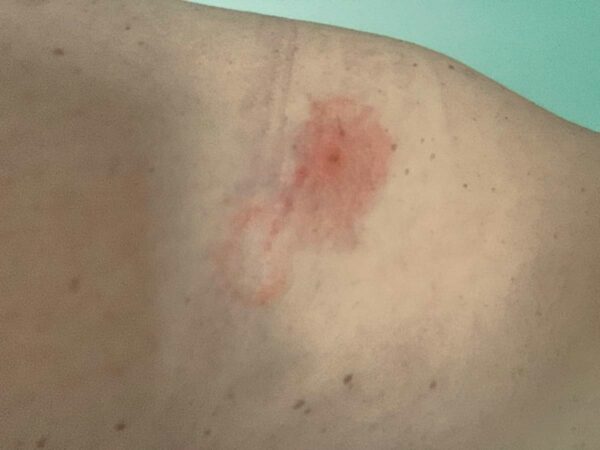
(Updated 8/19 at 12:25 p.m.) Some Arlingtonians suspected it a few weeks ago, and an entomologist with Virginia Tech has now confirmed it: those mysterious, itchy red bug bites generating a buzz here are likely from oak itch mites.
The Virginia Tech Insect ID Lab has not yet received a mite this year to study, Kirsten Ann Conrad, an extension agent for Virginia Cooperative Extension, tells ARLnow. But the mite theory nonetheless is likely correct, she says.
“No entomologist can identify a bug based on a bite. People have very different reactions to stinging biting insects,” she said. “In this case, there was plenty of circumstantial evidence that links outbreaks of oak leaf mites, and the resulting bites on humans, to cicada emergences.”
The mites are hard to track down because they’re between .2 and .8 millimeters and “nearly invisible,” according to a flier distributed by VCE’s Arlington and Alexandria offices. While they primarily feed on the eggs and larvae of the oak leaf gall midge and wood boring insects, they’re here because of the abundance of cicada nymphs. The mites bite humans when they run out of options.
“Humans are not their first choice of food,” Conrad said.
The author of the flier, Conrad said she has been getting complaints of “large raised, red skin welts and extreme itching” directly from residents and during VCE’s various educational sessions. (An Arlington County spokesman declined comment and referred us to VCE’s statements.)
The bites and mites have also been widely reported in the media. After ARLnow first reported that residents were being bitten and suspected oak itch mites, the phenomenon was covered by TV stations, the Washington Post, and even other national and international outlets.
We later unscientifically polled readers to see if they think they’ve been bitten by these mites. About 93% of the 5,463 respondents reported that they have been bitten by the mites anywhere from once to “a lot.”
“It seems to be very local,” Conrad said. “And I don’t know what the extent of the problem is outside of the areas in which we had the Brood X emergence.”
The high response rate is not surprising, according to Conrad, who said that during a 2004 outbreak in Crawford County, Kansas, the Centers for Disease Control and Prevention estimated that about 54% of the population suffered from the bites.
While the attacks have been linked to the Brood X emergence, a cyclical occurrence, people have told Conrad they’ve never been bitten like this before.
“People here say to me that when, 17 years ago, the last Brood X emerged, they don’t remember having such an outbreak of these itch mites then,” she said. “This is my first ever experience with them myself.”
The wet, windy weather could also be to blame.
“Their success is attributed to prolific reproduction and their dispersal by wind,” according to the flier. “These microscopic mites travel with the wind, and it is likely that moist weather and abundance of food supply has caused the population of these common insects to grow.”
As for how long they’ll stick around, Conrad says there has been speculation that the mites could be a problem until frost arrives.
“I hope not, because I’ve been getting those bites too,” she said. “I can tell you that — and this seems to be contradictory — cool, moist weather conditions favor the growth of the population, which is not what we’ve had this summer.”
As for the bites, they’re not life-threatening. Typically, the itching starts within 10 to 16 hours after the mite bites and can last up to two weeks. Conrad advised using over-the-counter products to reduce itching and inflammation, such as calamine lotion, Benadryl and After-Bite, and advised people to see their doctor if the irritation requires medical attention.
Dr. Hong Hanh Nguyen, with Virginia Hospital Center, said she’s been seeing a number of patients seeking treatment for bug bites.
“From what we’ve been seeing, the itching resulting from the bite can last about two weeks and experts have suggested that we may be seeing bites from the mites until about October,” Nguyen said. “We recommend using over the counter Cortisone ointment to decrease the swelling and itching and have also recommended the use of Sarna cream for itching, both can be used multiple times a day. Ice, even just rubbing on an ice cube on the bite for 10 seconds or so, can also help reduce the itch.”
When going outside, people can apply repellents such as DEET formulations, IR-3535, picaridin and oil of lemon eucalyptus, Conrad said. People who are particularly sensitive to bites should don long sleeves, a hat and long pants when outdoors, she said. Showering and washing clothing after coming inside can help.
Treating oak trees with pesticides, however, “is not recommended nor is treatment of trees showing cicada damage,” she said.

